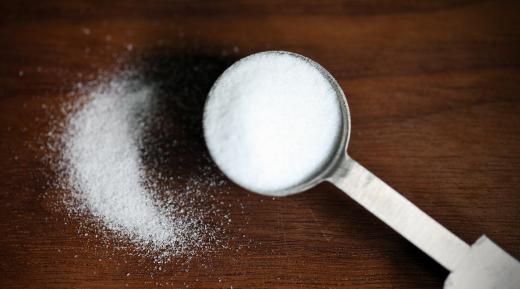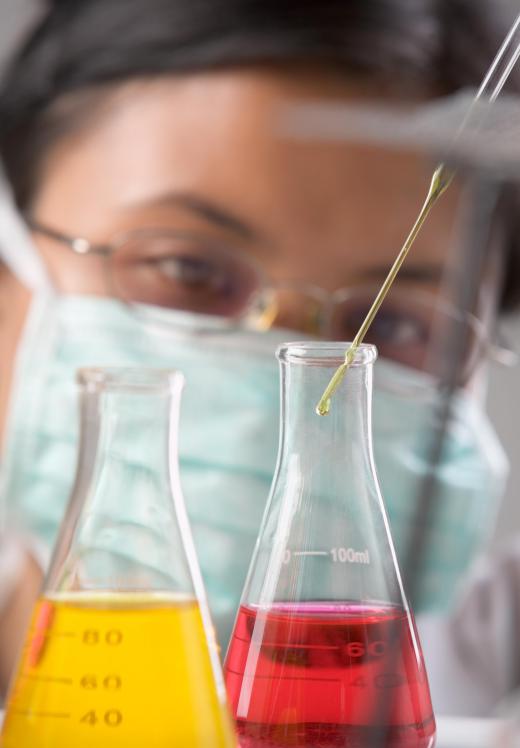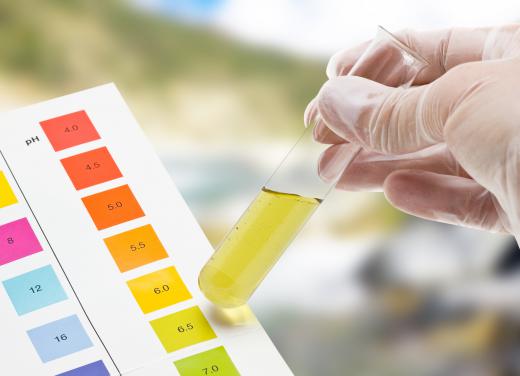What is the Difference Between an Acid and a Base?
 Niki Foster
Niki Foster
An acid and a base are both chemical compounds that change the pH, or the concentration of hydrogen ions, of water they are dissolved in. Acidic solutions have a low pH, under 7.0, while basic (alkaline) solutions have a pH of over 7.0. The pH of pure water is around 7.0 and is considered neutral. Acids and bases can be considered opposites of each other, and when they interact, neutralization occurs, producing a salt and water.
A hydrogen ion is a bare proton that carries a positive electrical charge. Atoms are made up of positively-charged protons and negatively-charged electrons, and in their stable state, the number of protons and electrons is equal, resulting in no net charge. Ions are molecules that do not have an equal number of protons and electrons, resulting in a net positive or negative charge. A stable hydrogen atom has a single proton and a single electron, so a bare proton is a positive hydrogen ion.

While acids release hydrogen ions when dissolved in water, bases release hydroxide ions, consisting of one oxygen atom and one hydrogen atom with a net negative charge. Therefore, acids increase the concentration of hydrogen atoms in the water in which they are dissolved, while bases decrease the concentration of hydrogen atoms, as their negative charge attracts the bare protons. When hydroxide ions and hydrogen ions combine, the result is water or H2O, consisting of two hydrogen atoms and one oxygen atom with no net charge. An acid or a base can both be liquid, solid, or gaseous.

There are also differences in the physical properties of an acid and a base. Acids, such as vinegar and the citric acid in lemon juice, are sour to the taste and they can produce a stinging sensation on mucous membranes. Bases have a bitter taste and a slimy or soapy texture. Either can be dangerous if they are too strong, approaching 1 or 13 on the pH scale, and some may be dangerous for reasons other than their high acidity or alkalinity.

Some common acids include vinegar, with a pH of 3, and lemon juice, with a pH of 2. Some common bases include baking soda, with a pH of 9, and ammonia, with a pH of 11. Stomach acid has a pH of 1, which is why basic solutions like baking soda can help neutralize stomach acid. Over-the-counter antacids typically have a pH of 10.
AS FEATURED ON:
AS FEATURED ON:















Discussion Comments
Many home remedies for food-related ailments can be linked to acids and bases. For example, it is commonly recommended that if you eat too much spicy food and feel sick, you should drink milk. This is because milk is a base, and that counteracts the acidic qualities of spicy foods.
Call me a chemistry nerd, but I think that what happens when you mix an acid and a base is so fascinating -- it can be either useful or dangerous. One very common useful reaction is the one that occurs when mixing vinegar (an acid) and baking soda (a base.) This is the solution commonly used when making a model volcano to make it erupt. The resulting foaming action causes the volcano to look like it is erupting. However, this same foaming action can be useful for more common tasks as well, such as unclogging a drain or freshening a garbage disposal.
Post your comments